Garlic
Plant Genetic Resources and Crop Improvement
|
Agrifound White (G-41): Bulbs are compact, silvery white with creamy flesh. Diameter of bulb is 3.5 to 4.5 cm.Cloves bigger elongated and 20-25 in number/bulb.They contain41 0B total soluble solids, 43% dry matter and 27 micro mole/g pyruvic acid. Crop matures in 140-150 days. It gives an average yield of 130 q/ha. The variety is notified by the Govt. of India for growing in Maharashtraand Madhya Pradesh.
|
 |
|
Yamuna Safed (G-1): Bulbs are compact, silvery whitewith creamy flesh.Diameter of bulb is 4.0-4.5 cm. Cloves aresickle shaped and25-30 in number/bulb.They contain 38 0B total soluble solids,40% dry matter and 29 micro mole/g pyruvic acid. Cropmatures in 140-150 days. It gives an average yield of 150-175 q/ha.The variety is notified by the Govt. of India for cultivation all over the country.
|
 |
|
Yamuna Safed-2 (G-50): Bulbs are compact,attractive with white creamy flesh.Diameter of bulb is 3.5-4.0 cm. The number of cloves is 35-40per bulb. They contain 39 0B total solublesolids, 41% dry matterand26 micro mole/g pyruvic acid. The crop matures in 140-160 days. It gives an averageyield of 150-200 q/ha. The variety is notified by theGovt. of India forcultivation in the Northern parts of India.
|
 |
|
Yamuna Safed-3 (G-282): Bulbs are creamy white,bigger in sized and 4.5-5.5 cm in diameter.The number of cloves is 15-16per bulb. They contain 40 0B total soluble solids, 42% drymatter and 25 micro mole/g pyruvic acid. The cropmatures in 120-140 days. It gives an average yield of 175-200 q/ha. The variety has been notified by theGovt. of India for growing in Madhya Pradesh, Maharashtra, Haryana, Gujarat, Punjab, Rajasthan,Uttar Pradesh and Chhattisgarh.
|
 |
|
Yamuna Safed-4 (G-323): Bulbs are silvery whiteand3.5-4.0 cm indiameter.The number of clovesis 20-25per bulb. They contain 42 0B total soluble solids, 44.5% dry matterand 25 micro mole/g pyruvic acid. The crop matures in140-150 days.The variety gives an average yield of 175-200 q/ha. It has beennotifiedby theGovt. of India for growing in North and Central India.
|
 |
|
Yamuna Safed-5 (G-189): Bulbs are creamy white and 4.5-5 cm in diameter. The number of cloves is22-30per bulb. The cloves contain42 0B total soluble solids, 44% dry matter and26 micro mole/g pyruvic acid and are suitable for processing.The crop matures in 140-160 days. The variety gives an average yield of 150-180 q/ha. It has been notified by theGovt. of India for growing in Zone III(Delhi, Uttar Pradesh, Haryana, Bihar and Punjab), Zone-IV(Rajasthan and Gujarat) and Zone VI (Maharashtra, Karnatakaand Andhra Pradesh).
|
 |
|
Yamuna Safed-8 (G-384): Bulbs are solid, white, flash attractive and dark greenplants. Diameter of bulb varies from 4.5 to 5.0 cm, 22-30 cloves per bulb. Bulbs contain 41 0B total soluble solids, 42% dry matter and 26 micro mole/g pyruvic acid. Crop matures in 150-160 days after sowing. The average yield of variety ranges from 175 to 200 q/ha. It has been notified by the Govt. of India for growing in Zone II (Jammu, Punjab, Delhi, Haryana and Rajasthan).
|
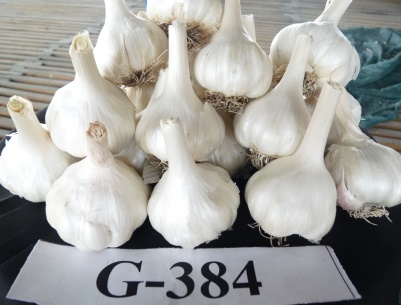 |
|
Yamuna Safed-9 (G-386): Bulbs are solid, light purple skin, attractive creamy white flash and dark greenplants. Diameter of bulb varies from 4.80 to 5.50 cm, cloves 22-30 per bulb. Bulbs contain 40 0B total soluble solids, 43% dry matter and 25 micro mole/g pyruvic acid. Crop matures in 150-160 days after sowing. The average yield of variety ranges between 180 and 225 q/ha. The variety has been notified by the Govt. of India for growing in Zone II (Jammu, Punjab, Delhi, Haryana and Rajasthan).
|
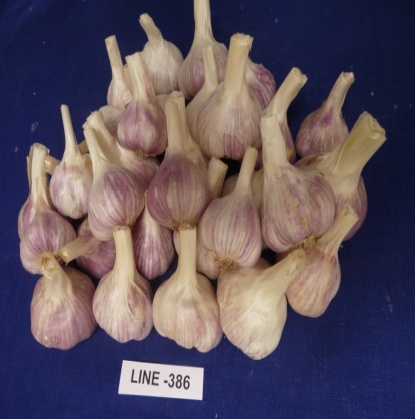 |
|
Agrifound Parvati (G-313): Bulbs are bigger, creamy white in colour with pinkish tinge.Diameter of bulb varies from 5.0 to 6.5 cm, 10-16 bigger cloves per bulb.Bulbs contain 36 0B total soluble solids, 38.5% dry matter and 23 micro mole/g pyruvic acid.Crop matures in 230-250 days after sowing.The average yield of variety ranges between 200 to 225 q/ha.The variety has been notified by the Govt. of India for growing in Zone I (Jammu Kashmir, Himachal Pradesh and Uttarakhand).
|
 |
|
Agrifound Parvati-2 (G-408): Bulbs are bigger, creamy white in colour. Diameter of bulb varies from 5.0 to 6.0 cm, cloves bigger 12-14 in numberper bulb. Bulbs contain 37 0B total soluble solids, 39% dry matter and 23 micro mole/g pyruvic acid. Crop matures in 240-260 days after sowing. The average yield of variety ranges between 200 to 225 q/ha. It has been notified by the Govt. of India for growing in Zone I (Jammu Kashmir, Himachal Pradesh and Uttarakhand).
|
 |
|
Advance line G-389: Bulbs are compact, white in colour with creamy white flash. Diameter of bulb varies from 3.0 to 5.0 cm and number of cloves 20-25 per bulb.Bulbs contain 34-36 0B total soluble solids, 35-38% dry matter.Crop matures in 75-80 days after sowing in kharif and 85-90 days in rabiseason.The average yield of line ranges between 40-60q/ha in kharifand 60-70 q/ha in rabi season.It has been released for growing in kharif season in Maharashtra, Gujarat and Madhya Pradesh.
|
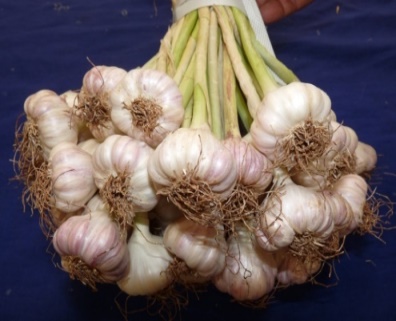 |
|
Yamuna Purple-10 (G-404): Bulbs are compact, attractive light purple in colour with creamy flesh. Diameter of bulb varies from 4.8 to 5.5 cm and bigger elongated cloves 25-30 in numberper bulb. Bulbs contain 40 0B total soluble solids, 42.9% dry matter and 26.8 micro mole/g pyruvic acid. Crop matures in 230-250 days after sowing. The average yield of variety ranges between 200 and 225 q/ha. It has been notified by the Govt. of India for growing in Zone II (Delhi, Rajasthan, Haryana, Jammu & Kashmir and Punjab) and Zone IV (Punjab, Tarai region of Uttar Pradesh, Uttarakhand, Bihar and Jharkhand)..
|
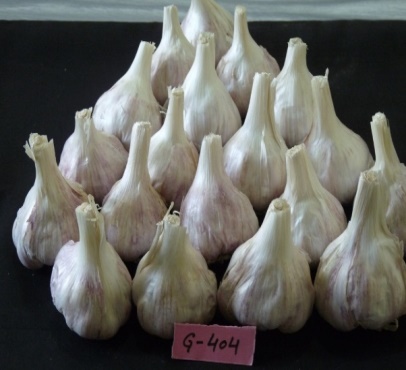 |
|
Yamuna Safed-6 (G-324): Bulbs are compact, white in colour with creamy white flash and better keeping quality. Diameter of bulb varies from 4.50 to 4.80 cm and 27-30 cloves per bulb. Bulbs contain 39-40 0B total soluble solids, 42% dry matter and 25.5 micro mole/g pyruvic acid. Crop matures in 155-165 days after sowing. The average yield ranges between 145 and 150q/ha. The variety has been recommended for growing in kharif season in Maharashtra, Gujarat and Madhya Pradesh.
|
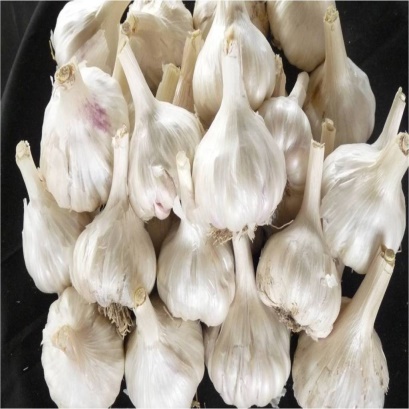 |
|
Yamuna Safed-7 (G-378): Plants are straight with dark green leaves. Bulbs are compact, bold white in colour. Diameter of bulb varies from 4.50 to 4.80 cm and number of cloves 20-25 per bulb. Bulbs contain 38-39 0B total soluble solids, 41% dry matter and 25.0 micro mole/g pyruvic acid. Crop matures in 145-150 days after sowing. The average yield ranges between 155 and 165q/ha. The variety has been recommended for growing in hilly areas.
|
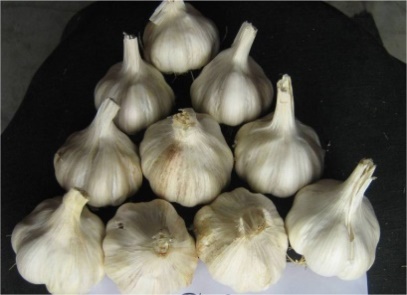 |
|
Advance line G-417: Plants are straight with broad dark green leaves. Bulbs are compact, attractive creamy white in colour with creamy flesh. Diameter of bulb varies from 4.5 to 5.0 cm with 26-35 cloves per bulb. Bulbs contain 39-40 0B total soluble solids, 42% dry matter and 25.0 micro mole/g pyruvic acid. Crop matures in 150-160 days after sowing. The average yield ranges between 160-165 q/ha.
|
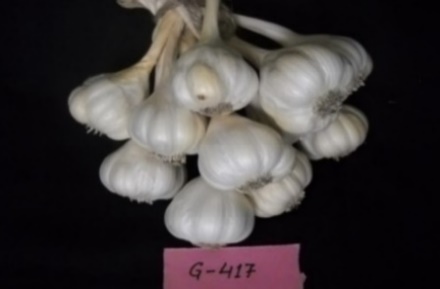 |
|
Advance line G-363: Plants are straight with moderate green leaves. Bulbs are compact, attractive white in colour withcreamy flesh. Diameter of bulb varies from 4.5 to 5.20 cm with 26-35 cloves per bulb. Bulbs contain 39-40 0B total soluble solids, 42% dry matter and 26.0 micro mole/g pyruvic acid. Crop matures in 150-160 days after sowing. The average yield ranges between 150-165 q/ha.
|
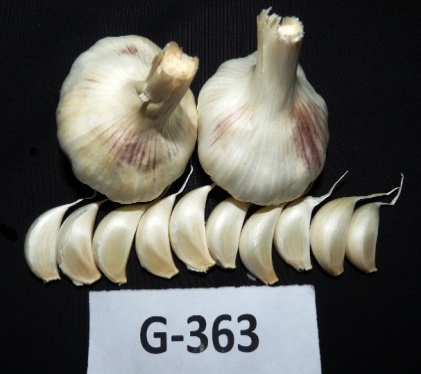 |
|
Advance line G-304: Plants are straight with broad dark green leaves. Bulbs are bold compact, attractive white in colour with creamy flesh. Diameter of bulb varies from 4.5 to 5.0 cm with 24-30 cloves per bulb. Bulbs contain 38-39 0B total soluble solids, 41% dry matter and 25.0 micro mole/g pyruvic acid.Crop matures in 150-160 days after sowing.The average yield ranges between 160-170 q/ha.
|
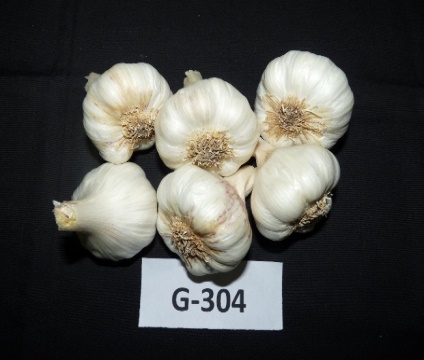 |
| |
|
Crop Production System Management
The planting of garlic cloves of 8-10 mm size at a spacing of 10-12.5 cm x 7.5. cm in the month of October is recommended for obtaining higher bulb yield, however, for quality bulb production planting at 15.0 cm x 10.0 cm spacing is recommended. The planting of garlic is generally recommended from 15th Oct. to 15th Nov. however, planting from 15th Oct. to 30th Oct. is recommended for Karnal conditions of Haryana and 25th Oct. to 5th Nov. under Nashik condition of Maharashtra.
Besides Nitrogen-Phosphorus-Potash (NPK) (100:50:50 Kg/ha) the use of Sulphur @ 30-50 Kg/ha and Zinc sulphate @ 20 Kg./ha are recommended for enhancement in yield and quality. The use of specialty fertilizers (water soluble fertilizers) as NPK -19:19:19 @ 1 % at 30,45 and 60 DAP followed by NPK -13:0:45 @ 1 % at 75, 90 and 105 DAP increase the yield and enhance the storability substantially. The fertigation in 10 splits are recommended for higher bulb yield. For garlic grown on Avid system, the integrated nutrient management is recommended with saving of 50 % chemical fertilizers (NPK @ 50:25:25 Kg./ha + Sulphur @ 25 Kg./ha + Zinc @ 10 Kg./ha + Azospirillum or Azotabactor @ 10 Kg./ha + Phosphate solubilizing bacteria @ 10 Kg/ha) to 70 % chemical fertilizers (NPK @ 30:15:15 Kg./ha + Suphur @ 15 Kg./ha + Zinc @ 6 Kg./ha + foliar spray of Polyfeed @ 1 % at 15, 30 and 45 DAP followed by Multi-K @ 1 % at 60, 75 and 90 DAP) without any significant reduction in yield with improvement in soil health and environmental soundness in comparison to standard check (NPK @ 100:50:50 Kg./ha + S @ 50 Kg./ha +Zn @ 20 Kg/ha).The farm application of GA3 @ 25 ppm at 45& 60 DAP have been recommended to enhance the yield of garlic and improve the quality under Nashik condition of Maharashtra and Karnal conditions of Haryana.
Use of Pendimethalin @ 3.5 l/ha + one handweeding or Oxyfluorfen @ 0.25 Kg a.i/ha + one handweeding are recommended for effective control of weeds in garlic.
The irrigation at 1.5 CPE (Cumulative Pan Evaporation) is recommended for higher yield of quality garlic bulbs. Drip irrigation is recommended in garlic grown on raised bed to get higher bulb yield.
Plant Health Management
Foliar diseases
Foliar spray of mancozeb (Dithane M-45) @ 0.25% or Ziram (Dithane Z-78) @ 0.3 % with sticker Triton @ 0.06% at fortnightly intervals after appearance of disease recommended to control the purple blotch (Alternaria porri) and stemphylium blight (Stemphylium vesicarium) of garlic.
15th October planting of garlic cloves in Nashik (Maharashtra) was found suitable for reducing the prevalence of diseases and thrips in garlic varieties us Yamuna safed, Yamuna safed-2 and Yamuna safed-3 and 15th September for Agrifound white during rabi season. 15th September planting of garlic clove in Karnal (Haryana) was found suitable for reducing the diseases and insect pest in garlic varieties us Yamuna safed, Yamuna safed-2, Yamuna safed-3 and 15th October for Agrifound white during rabi season
Management of thrips
Sprays of deltamethrin 2.8% EC @ 0.095% at 15 days interval or fipronil 5% SC @ 0.1% at 10 days interval or profenofos 50% EC @ 0.1% or spinosad 45% SC @ 0.1% is recommended for reducing thrips population and increasing yield.
Post Harvesting Technology
Harvesting of garlic at 75 – 100% neck fall stage, windrow curing till complete drying of tops and neck cutting leaving 2.5cm neck above bulb and storage in nylon-netted bags are recommended to reduce post harvest losses in garlic. The cloves treated with Potassium orthophosphate solution @1% for 15 minutes before planting are recommended to minimize the storage loss in garlic. The garlic variety Yamuna sated-3 planting on 5th Nov. is recommended for level losses at Nashik ( for 6 months) as well as Karnal (for 9 months).
Artificial curing of garlic bulb variety Agrifound Parvati grown in Kullu vally in curing chamber with full load at 350C and velocity of airflow at 3.2 m/s. for 14 hours is also recommended for adoption in view of lower storage losses during storage.
The garlic genotype G-189 is recommended for processing purpose in view of having desired dehydration qualities.